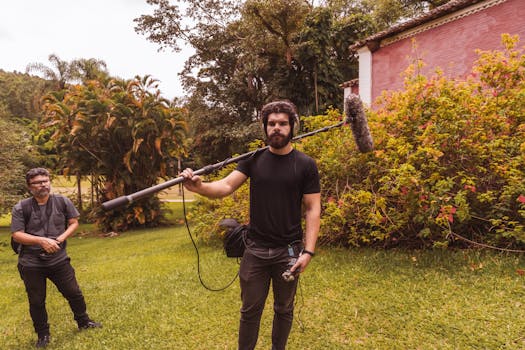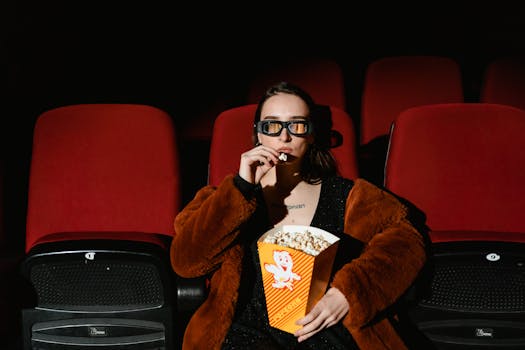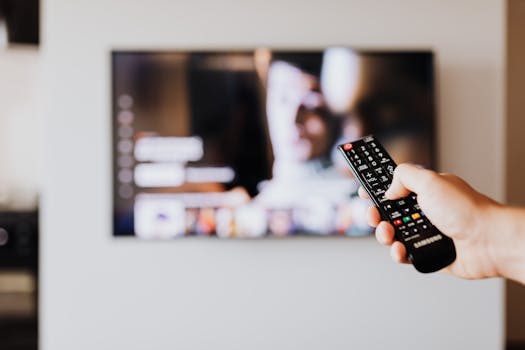Movies
Iconic Movie Scenes That Were Never in the Script
Explore how iconic movie scenes were created by unscripted brilliance, improvisation, and pure chemistry. Learn why these moments still redefine film magic and inspire every creative project.
Advertisement
Sometimes a line, gesture, or unexpected moment jumps out of a movie and lodges in our collective memory. Think of iconic movie scenes—those flashes of pure magic—where actors broke from the script and changed film history.
Unscripted moments have shaped the way we remember classic films. These occurrences didn’t just enhance a scene, they revealed new depths in characters and created timeless cultural references that still echo in popular conversation.
This journey explores how improvisation, quick thinking, and actor-director chemistry created some of the most iconic movie scenes ever filmed. Let’s dive into these cinematic surprises and pick up lessons any film fan can appreciate.
Improvised Brilliance That Stole the Show
Learning the mechanics behind movie magic lets you spot improvisation and appreciate film even more. Iconic movie scenes frequently emerge when spontaneity disrupts the expected flow.
When actors leave the boundaries of a set script, the energy can shift. Directors sometimes encourage this, trusting chemistry between co-stars to generate something real and raw.
Unexpected Genius: Marlon Brando in The Godfather
Marlon Brando instinctively put an orange peel in his mouth and transformed a simple garden scene into a moment both hilarious and poignant. Viewers repeat the imagery because it feels unsettling and genuine.
Brando’s unscripted orange-peel teeth surprised even his fellow actors, sparking authenticity on camera. This tiny act, unplanned and instinctive, became a defining visual for an entire cinematic era.
Applying this logic, next time you rewatch a classic, look for organic moments that let characters feel real—and ask yourself if they might be improvised.
Harrison Ford’s Swift Solution in Raiders of the Lost Ark
On set, Harrison Ford felt ill the day they shot the notorious sword fight. Instead of acting out a complex duel, he simply drew his gun and fired. The crew’s laughter made the director keep it.
Now that moment’s an iconic movie scene. It teaches us filmmakers sometimes let practicality drive artistry. When an actor’s genuine action feels right, running with it can create true movie gold.
If you ever wonder what drives a memorable line or shot, remember how necessity and quick thinking write history. Try applying that lesson in any creative project where plans go awry.
| Film | Actor | Iconic Improvised Moment | Why It Worked |
|---|---|---|---|
| The Godfather | Marlon Brando | Orange peel teeth | Surprised crew, timeless imagery. |
| Raiders of the Lost Ark | Harrison Ford | Simple gunshot saves time | Felt real, became iconic instantly. |
| Jaws | Roy Scheider | “You’re gonna need a bigger boat.” | Crew joke, perfect tension breaker. |
| The Dark Knight | Heath Ledger | Clapping in jail cell | Built Joker’s unpredictability and energy. |
| Pretty Woman | Richard Gere, Julia Roberts | Snapping box shut on necklace | Created spontaneous laughter and warmth. |
Moments Born from Pure Chemistry
Recognizing when actor relationships add sparks lets you pinpoint iconic movie scenes growing from genuine reactions instead of written cues. Real chemistry creates layers even a detailed script can’t predict.
When stars genuinely enjoy working together, dialogue flows differently. Body language and playful energy elevate what could be standard exchanges into striking, memorable sequences audiences replay again and again.
Timeless Connection: When Dialogue Shifts Naturally
In Pretty Woman, the jewelry box snap scene emerged as a light prank. Julia Roberts’s laughter wasn’t in the script—it was Richard Gere’s way of making the moment shine.
Reactions like hers reveal real rapport. Directors keep rolling when actors riff off each other. Memorize the emotional beat that landed in this example and see if you spot other genuine giggles in romantic comedies.
- Notice spontaneous laughter and unplanned reactions—these indicate authentic chemistry you can celebrate as an iconic element, not a director’s calculated setup.
- Track breaks in eye contact or quick improvisational lines—hinting at live energy between stars that leave an impression far beyond the cut.
- Read interviews for behind-the-scenes stories—producers and actors often share “that wasn’t in the script!” tales about now-famous moments you catch on screen.
- Identify when dialogue sounds natural rather than polished—real conversations slip out when performers feel free to try new ideas and reactions together.
- Spot visible surprise—when a performer truly reacts, viewers feel included in the surprise, making these scenes instantly iconic movie scenes upon release.
Use these tips to spot chemistry that produces iconic movie scenes. Applying this awareness turns every viewing into a treasure hunt for authentic moments.
Small Shifts That Create Lasting Impact
Sometimes chemistry changes the narrative. In Good Will Hunting, Robin Williams improvised his wife’s story. Matt Damon’s laughter was real—evidence of real emotion blending with script.
Unscripted warmth or surprise feels different. You can use this in your own creative teamwork—practice small improvisations to break tension or inject energy in group projects.
- Encourage off-script discussions in meetings—unexpected stories might reveal talents or ideas that move your team forward, as in filmmaking.
- Celebrate mistakes—sometimes a slip-up, like an actor fumbling a prop, can create joy or highlight problem-solving in the moment, both on screen and in groups.
- Take creative breaks—humor and relaxed moments encourage unscripted insights, much as improvisation does between actors filming iconic movie scenes.
- Embrace surprise outcomes—when things don’t go as planned, be open to pivoting (like directors do on set) for improved results.
- Recognize authentic emotion—look for genuine laughter, surprise, or tears; these signals mean your group has reached new personal or creative territory.
Build a habit of recognizing serendipitous moments. These brief flashes of inspiration define memorable collaborations in every field, just as they create iconic movie scenes.
Iconic Lines Actors Invented on the Spot
Hearing an unforgettable line in a film? Understanding its impact helps you appreciate its legacy. Some famous cinematic quotes arose from quick wit, not any screenwriter’s vision.
Lines birthed in the moment become movie folklore, quoted endlessly. Their authenticity resonates, proving that actor intuition can deliver more staying power than lines revised during pre-production.
“You’re Gonna Need a Bigger Boat”: The Jaws Phenomenon
Roy Scheider wasn’t supposed to tell Chief Brody he needed a bigger boat. The phrase started as a crew inside joke, but it delivered perfect comic timing when tension peaked.
Fans adopted the line immediately. It remains one of the most iconic movie scenes because it feels spontaneous yet true to the character’s fear in that situation. Scripts alone rarely produce such pop culture gold.
When you watch future thrillers, listen for moments where dialogue feels especially alive. These bursts of energy typically signal a break from the script—organic, memorable, and perfectly timed.
Heath Ledger Elevates the Joker
Heath Ledger, playing the Joker in The Dark Knight, began to clap slowly and eerily during a police cell scene, not written in the script. Cast and crew picked up on the energy.
That oddball applause became chilling, adding layers of unpredictability. Ledger’s choice amplified the Joker’s menace. Now, even small gestures in tense scenes get extra attention from fans and filmmakers alike.
Try noticing small, offbeat reactions in performances. They hint at actor creativity and can reveal a character’s inner chaos—useful to remember when analyzing any complex role.
Gestures and Body Language Tell the Real Story
Privacy or hesitation sometimes produces small movements that heighten drama. These behaviors lend realism to iconic movie scenes, bridging scripts and audience memory.
Gestures created on the fly push performances beyond words. Movie fans can learn to read between the lines and understand character intent through improvisational body language in favorite films.
Building Tension with a Single Glance
In Silence of the Lambs, Anthony Hopkins’ notorious hissing wasn’t planned. Paired with his fixed glare, he crafted a chilling moment from almost nothing. Viewers reported feeling genuinely disturbed.
When an actor changes stillness to motion, suspense rises. Watching for such subtle shifts gives you insight into impromptu performance decisions—essential for appreciating layered, iconic movie scenes.
This attention to micro-movements can carry over to your daily reading of body language. Spot subtle cues—like nervous fidgeting or held breath—to better understand people’s intentions in real life.
Translating Physical Improvisation into Daily Communication
Physical improvisation conveys emotion even when words can’t. In 12 Angry Men, actors reportedly paced, fiddled, or leaned closer, creating tension organically and pushing the narrative along with their movements.
The human mind remembers these nonverbal cues more vividly than memorized dialogue. Try leaning forward or pausing intentionally when you want to emphasize a point in workplace or family discussions.
Consider the “show, not tell” lesson from film, adding expressive gestures in your communication to become more compelling and relatable.
When Directors Encourage Unplanned Magic
Directors who foster improvisation often uncover iconic movie scenes that feel uniquely authentic. Giving actors the space to experiment frequently results in bold choices that transform an entire film.
You can spot directors’ loose reins in films with chaotic energy, natural speech, or unpredictable moments. Look for movies with fluid camera movement or group scenes that seem genuinely messy or unscripted.
The “Let’s See What Happens” Approach
Directors like Martin Scorsese prefer working with rough outlines instead of rigid scripts. He encouraged Robert De Niro to improvise in Taxi Driver, resulting in the legendary “You talkin’ to me?” soliloquy.
Scorsese’s gamble paid off, proving that allowing actors creative freedom can reveal deeper character truths than planned dialogue might.
In daily life, try this technique by setting boundaries but letting collaborators run with their ideas, just as a director exploits spontaneous genius on set.
Group Dynamics and Improvised Conversations
Paul Feig’s Bridesmaids benefited from encouraging its cast to riff in key scenes, turning chaotic dinner sequences into hilarious and relatable showdowns. Each take brought a new shade of energy.
Direct observation of actor dynamics led Feig to recognize which improvisations to keep. He watched, laughed, and then built the edit around these unpredictable moments.
Team leads or facilitators can use this approach. Watch how group energy shifts, capture the best parts, and build a project around that core spark for the strongest results.
Signs You’ve Spotted an Unscripted Gem
Spotting improvisation in movies sharpens your movie-watching skills. Some cues reliably signal you’re seeing an unscripted moment, helping you appreciate iconic movie scenes more deeply.
- Watch for stifled laughter: If a performer nearly cracks up or breaks character, you’ve likely caught an unscripted moment.
- Look for abrupt cuts or quickly changing camera angles—they can hide corpses of laughter or unplanned moves that ended up perfect.
- Listen for dialogue that sounds less polished or more like natural conversation—these lines tend to originate from improvisation.
- Notice a co-star reacting unexpectedly—real surprise on their faces suggests an improvised element snuck into the scene.
- Read body language cues—fidgeting, glancing at crew, or “checking” gestures can all suggest the moment was not rehearsed repeatedly.
Put this checklist into practice the next time iconic movie scenes make you laugh, gasp, or rewind. Discovery becomes part of the enjoyment.
Lessons from Iconic Movie Scenes for Your Creative Practice
Watching how spontaneity shapes film teaches you to accept unpredictability in life’s creative pursuits. Iconic movie scenes show that rigid plans are rarely necessary for achieving unexpected excellence.
Apply film improvisation strategies to your own art, writing, or collaborations. Welcome accidents and keep your creative process open-ended for happy surprises.
Cultivate habits that mirror what directors and actors do: experiment, encourage input, and review results for flashes of brilliance you didn’t anticipate. These skills translate across any project, personal or professional.
Every Iconic Movie Scene Tells Its Own Story
Looking back, the best iconic movie scenes didn’t just surprise actors and filmmakers—they redefined how we talk about film, quote lines, and share stories with others.
Remaining open to happy accidents, as movies prove, isn’t just useful for artists. These scenes reveal that authenticity wins audience loyalty in any context, from boardroom brainstorming to weekend filmmaking attempts.
Carry this lesson forward: let curiosity and courage override perfectionism, both in creative endeavors and in the way you watch and talk about movies. There’s magic in embracing what you never planned.
You may also like

How Sound Design Shapes the Emotional Power of Film
See how sound design in film shapes emotion, builds tension, and transforms simple moments into unforgettable cinematic power.
Keep Reading
Hidden Movie Endings That Completely Change the Story
Discover hidden movie endings that completely shift meaning, twist expectations, and make audiences rethink the story’s truth.
Keep Reading


